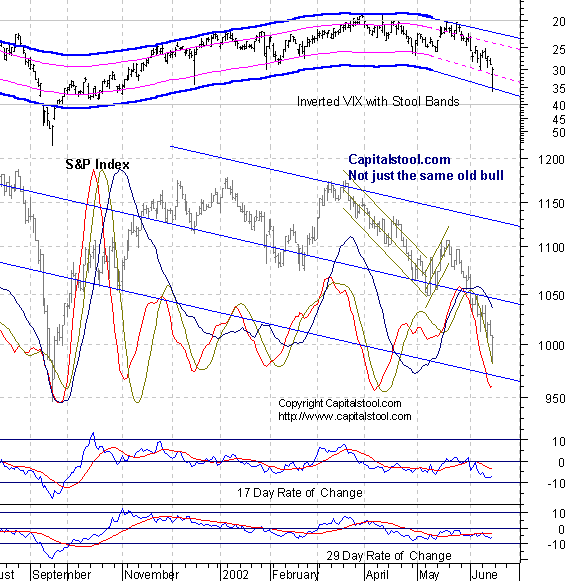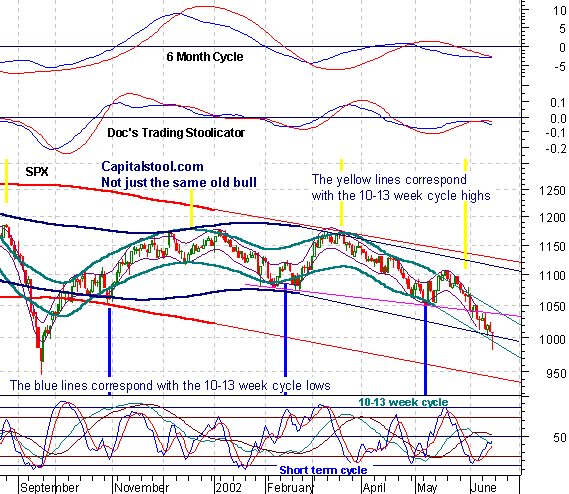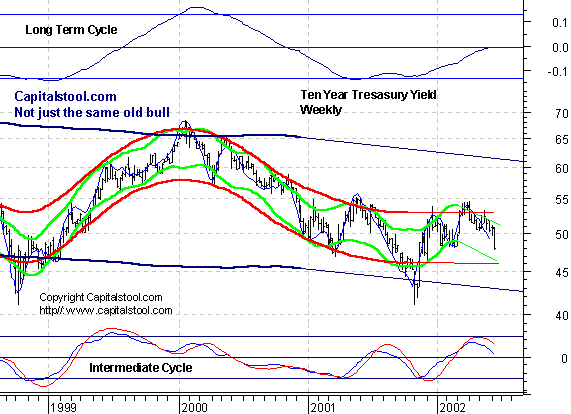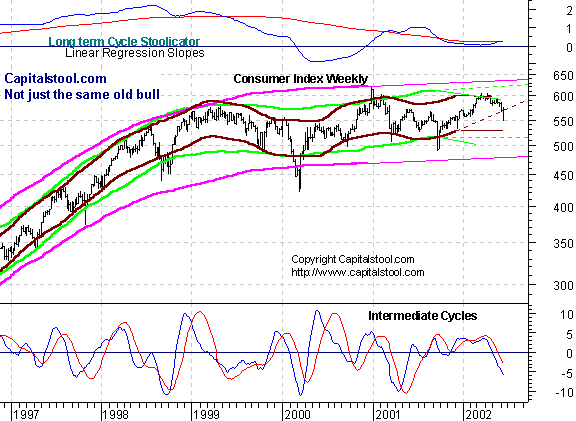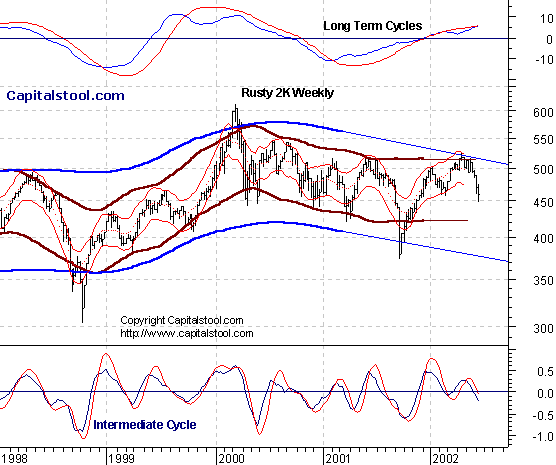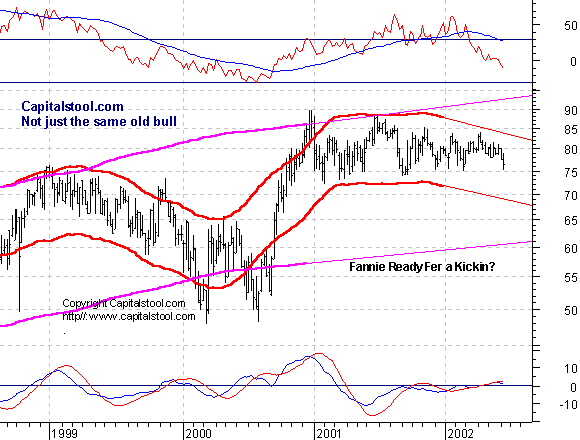|
10 Minute Bar Charts 6/14/02 Dow Jokes Inflatables
Archives 12/30/01, 1/1/02, 1/2/02, 1/3/02, 1/4/02, 1/7/02, 1/8/02, 1/09/02, 1/10/02, 1/11/02, 1/14/02, 1/15/02, 1/16/02, 1/17/02, 1/18/02, 1/22/02, 1/23/02, 1/24/02, 1/25/02, 1/28/02, 1/29/02, 1/30/02, 1/31/02, 2/1/02, 2/4/02, 2/5/02, 2/06/02, 2/7/02, 2/9/02, 2/11/02, 2/12/02, 2/13/02, 2/14/02, 2/16/02, 2/19/02, 2/20/02, 2/21/02, 2/23/02, 2/25/02, 2/26/02, 2/27/02, 2/28/02, 3/1/02, 3/04/02, 3/05/02, 3/06/02, 3/7/02, 3/10/02,3/11/02, 3/12/02, 3/13/02, 3/14/02, 3/15/02, 3/18/02, 3/19/02, 3/20/02, 3/21/02, 3/22/02, 3/25/02, 3/26/02, 3/28/02, 3/30/02 4/1/02, 4/2/02, 4/3/02, 4/4/02, 4/6/02, 4/8/02, 4/9/02, 4/10/02, 4/11/02, 4/13/02, 4/15/02, 4/16/02, 4/17/02, 4/18/02, 4/20/02, 4/22/02, 4/23/02,4/24/02,4/25/02, 4/26/02, 4/27/02, 4/29/02, 4/30/02 5/01/02, 5/2/02, 5/4/02, 5/6/02, 5/07/02, 5/8/02, 5/09/02, 5/10/02, 5/13/02, 5/14/02, 5/15/02, 5/16/02, 5/17/02, 5/20/02, 5/21/02, 5/22/02, 5/23/02, 5/24/02, 5/28/02, 5/29/02, 5/30/02 6/01/02, 6/3/02, 6/4/02, 6/5/02, 6/6/02, 6/7/02, 6/10/02, 6/11/02, 6/12/02, 6/13/02
|
The Anals of Stock ProctologyPublished 5 times
per week by the American Academy of Stock Proctology and PM Update 6/17/02 1 PM Terms and methodology The 8 day cycle cmaps are now pointing a little higher 1575 or so on Nas and about 1042 on SPX. Could come today. A parabolic moonshot is in progress, constantly blowing out the 1 day cmaps, and obliterating the 1 day cycle. Although the new 1 day targets have been hit, the focus for should be on the 3 day numbers.
AM Update 6/17/02 9:45 AM Terms and methodology Updated cmaps considering the market's opening action.
AM Update 6/17/02 8:15 AM Terms and methodology Fucutures look like they want to follow through on Friday's turnaround, but they have hit their cmaps as of 8 AM, and the averages appear to have hit their cmaps as well. Doc thinks this will fizzle early followed by a pullback or consolidation until 12-1PM. The 3 day cycle looks like it will be in an up phase until Tuesday, with a push to higher highs, but nothing dramatic.
Beating the House (6/14/02) Perhaps the biggest lie on Wall Street is that stocks have intrinsic value. With the exception of those that actually pay a dividend, (a dividend you say, what's that?), stocks have no intrinsic value. They are intrinsically worthless because they have no utility, and pay no income (Dividend stocks excluded). They are nothing more than casino gambling chips, piece of papers, or electronic ledger entries. I keep hearing the term "fair value", and I am left to wonder just what that means. Fair value? Fair by whose standards? The idea that there is a normal PE ratio that should be assigned to stocks is baloney. How do you determine "normal PE." The risk free rate of return? Insane. That plus a premium? How much premium? As a stockholder, we don't receive the earnings. Hell we don't even know what they are. Most companies have no earnings. Sure they have acronyms and synonyms for real "profits", but how many have increased retained earnings? Even if we know what earnings are today, what will they be tomorrow? No one knows. The Street is playing make believe when it comes to earnings, and valuations, and everything else. What difference does it make anyway, if none of it flows to my pocket? And why do some stocks with no earnings have market values in the hundreds of billions. Shouldn't they be valued at zero? Wall Street likes to think it can predict both earnings and valuation levels. But they really have no idea. Accordingly, you have no idea what you can get back for the chips you hold when you get up in the morning. Maybe some stoolies have an idea, but it's just as likely to be the wrong idea. The value people, such as Warren Buffet, liken stock investing to buying a business. There's only one thing wrong with that. Unless you ARE Warren Buffet, you are not buying the business! You are not even buying a piece of the business. You receive no income, you have no say in the management, you have no control whatsoever over anything that goes on with the business. You have no right to use the business's property. What you have isn't worth squat. The same goes for anyone else with less than 50.1% of the stock, except the managers, who are in the business of extracting as much as they can from the business, for themselves. They could care less about you. Increasing shareholder value? How can you increase something that doesn't exist in the first place. Please. So the first thing is this. Regardless of what the textbooks say, common stocks have no intrinsic value. Their value in exchange, their market value, their PRICE is whatever someone will pay you for your stock at any given point in time. Stocks have a price. But unless they pay a dividend their investment value is ZERO. Buying stocks isn't about valuation. It's about gambling and speculation. There is no reason in the world for any stock to sell at 100 times earnings. The price represents a speculative premium just like an option. A high PE ratio is simply a measure of excess speculative fervor resulting from excess liquidity in the system. When there's too much liquidity in the system, speculative premiums increase. Usually business increases as a byproduct of the increased liquidity and increased speculation, i.e. the bubble effect. The idea that stock prices are going up because business is improving, or even sillier, the idea that stock prices somehow discount the future business conditions, is an illusion. It's a trick the markets play on people who never stop to consider that the conventional wisdom is ridiculous. Investors, especially professional poodits, cannot foresee the future. They have no idea whatsoever what the future holds. Stock prices don't go up because investors in their infinite wisdom are successfully forecasting and discounting the future. Stock prices go up before business conditions improve because the excess liquidity flows into stocks first. Business improves because stock prices go up and people have more money. Stock prices have nothing to do with the level of business or profitability, quite the opposite. When stock pricing appears rational it is simply an accident, like the stopped clock which is right twice a day. The value guys say it's like buying a business. Most small businesses sell for 1.5 or 2 times earnings. So if stocks can sell for 40 or 50 or 100 or infinity times earnings, there's no reason why any stock might not sell for 2 times earnings. Why are stocks worth any more? Because they're easier to sell? Is that worth 10,000 percent? What about the penalty for lack of control? As the liquidity slowly but surely comes out of this bubble, in spite of Al's best efforts to keep it inflatulated, the speculative PE ratios will come down. So far they haven't, because there's still an ocean of liquidity. But that is starting to change. The bubble effect is reversing as businesses divide themselves into ever smaller pieces to sell, just to pay their skeleton crews and their lenders. The process of businesses raising and consuming capital that began with the internet stocks will now spread throughout all sectors. Capital sources will begin to dry up. They already are. Business activity will slow and at some point everyone will think the stock market successfully discounted the drop in the economy. Instead, it will only be the fact that the stock market has become a source of the liquidity necessary to simply stay alive and pay creditors. Business and households alike need to continue selling stocks just to pay the bills. But the appetite and ability to buy stocks at a level necessary to keep prices at equilibrium no longer exists. The supply of stocks is high and increasing, and demand is insufficient and decreasing. Whether you think of yourself as an investor or a trader, long term or short, you are not buying a piece of the business. You are simply gambling, speculating on the future price of your chip. You have no way of knowing, based on the company's business, or current economic trends, what that chip is going to be worth. Its value is independent of the performance of the business. It may go up when business stinks if there's excess liquidity, and it will go down regardless, if liquidity dries up, which is what is happening now. When you place your bet, is it all you can do to just sit and hope that it pays off? Just as with the track or sports betting there is only one way to improve the chances that you will come out ahead. Handicapping. You have to handicap the races. You have to learn as much as you possibly can about the horses and how they run in all kinds of conditions and whether their recent performances have been strengthening or weakening. You have to know when your team is on a roll and when it sucks. And you have to know when they're getting drugs and when they're not! It's all about intelligent handicapping. In the stock market, you have to handicap the shifts in market liquidity, in the supply of and demand for a particular chip. You have to know the stock's supply-demand profile. You have to know when Al's distributing speedballs and when he's not, when the market is speeding, and when it's in withdrawal. You have to know what kind of mood people are in, which direction their mood is heading, and whether they're on Fed drugs or not. Handicapping the stock market can only be done through old fashioned tape reading with a little help from today's cutting edge tools, as well as a minimum of monetary analysis. Today we have all kinds of analytical tools and information sources with which to interpret the tape, liquidity flows, and the mood of the market. It is easier than ever before. So equip yourself with the tools, do your homework, learn to handicap, develop a model that you know inside out and backward, learn to read your own emotions and how they are part of that system, learn to read the emotion of the market, keep an eye on Al and the Gang, and learn to read the charts! Do all that and you'll be ahead of the game, and you'll beat the house time and again. It's not about the economy. It's not about valuations. It's not about earnings. It's not about the news. It's not about public confidence. Excess liquidity causes confidence to grow and lack of liquidity will break it. It is about liquidity! It is about the cycles of human emotion! The two have a lot to do with one another. Finally, and above all, it's about gambling intelligently. The goal of this publication is to assist you in doing that, and to have fun with you in the process. The Feed
did $2.25 billion in 4 day repos Friday, resulting in a net drain of
$4.25 billion from the coffers of the Gang of 22 and their clients,
which brings the Total Feed back to the bottom of the trend channel. This makes Doc more than a little
suspicious that Al has maneuvered the Feed into position for yet another
enormous jam, taking advantage of Friday's half vast "reversal
day." The bond market has given them a lot of leeway as well,
with yields dropping through the floor. The Fast Feedometer has pulled
back into neutral territory. A giant Feed of $10-20 billion cannot be
ruled out over the next couple of days. I have no idea whether Al's Bakery
intends to deliver a load of fresh bread or not, but there doesn't appear
to be any real constraint against it, at least in this
picture. The Slow Feedometer continues to
trend
up, following the bulge of two weeks ago. The champagne music machine is
doing it's best to keep blowing bubbles, obviously without success. It's
called the Japan syndrome.
Portfolio Sphincters Index (SPX) and Sentiment In spite of a 15 point comeback, the Sphincters Index managed to lose a couple points on the day. The 17 day rate of change, which represents the 6-7 week cycle, and the 6-7 week oscillator superimposed on the price chart, flattened a bit. The oscillator is down in Dover Sole territory. It needs to correct, but requires only a slowing of the downtrend to do so. The 10-13 week cycle oscillator (navy) dropped. This is a lagging, confirming indicator, early in the down phase. If the cycle runs its full term, which is at least another 4-5 weeks, the losses are going to be mind bending. But the centered moving average projections are only pointing to 972. Either the cycle will end earlier than projected, or the centered moving average projection will move lower. The 29 day rate of change held its ground in negative territory. A flat pattern in negative territory indicates a stable downtrend. The VIX rose to 29.93. On the inverted scale chart, VIX touched the outer band intraday, but the Stool Band is dropping fast. The market got a little panicky, in its ultimate journey to fear, and finally, extended panic. The trend is smooth, but the day to day movements within the trend are not, and as the market moves lower, intraday volatility will increase. The final bottom will be marked by an extreme reading for several days. The blue channel lines are the extension of a linear
regression channel from the February and May 2001 highs. The 6 month cycle
oscillator has flattened again. Flat in negative territory indicates
trending. The trading
stoolicator is inching down. The short cycle oscillator is still inching
higher relieving the Dover Sole condition as the up phase in the 4 week
cycle is underway. You'd never know it from the price action, but the up
phase is represented by a slight slowing in the rate of decline. This is priming the downtrend for
subsequent acceleration. The
possibility of a dramatic breakdown is probably still increasing. For now
the price action is confined within the cycle channel projections at a
steady trend rate. In the technical esoterica department, the SPX
broke below the 161.8%
fibo retracement level but stopped on the trendline formerly known as
support at 990. The Cycle Conditions tables include cycle phase and a wild guess as to number of periods to the next turn, in days for the shortest cycles, weeks (W) or months (M) for the longer ones. This is a fluid exercise, in other words, the projections are likely to be wrong, but they force us to be vigilant for key turning points, and frequently work well enough to prevent costly misreadings. SPX Cycle Conditions as of 6/14/02
PTT - Periods Till Turn On a day to day basis the market seems wild and
irrational. Over the long haul it is amazingly orderly. The question now
is whether the market is beginning to form an intermediate low, or will it
continue moving toward the lower channel projection around 900 before
bouncing? The next two weeks will be a time of uncertainty until the
question is answered. Nasgap Charts The Nasty actually finished up gaining 7.88. Like JJ KoolAid Cramer says, there's always a bull market somewhere. The 6 month
cycle time series spread is drifting lower. The 10-13 week cycle
oscillator and the trading stoolicator stopped, but remain in negative
configurations. The short cycle oscillator rose yet again and is now in positive territory. The index may try and pop, but there's no sign of sustainability on the upside, especially with the huge overhead supply. Conversely there's not enough selling to push the index through the lower channel bands and turn them more sharply lower, at least not yet. So expect a bumpy ride. The
Nascrap 100 will collapse if
it breaks the downtrending channel lines now around 1075, which it almost
did today. The next
fiber nacho level formerly known as support is at 1432. The descending
lower trendline acted as support on Friday. Nasdaq Cycle Conditions as of 6/14/02
PTT
- Periods Till Turn The
long term chart shows an extraordinary symmetry as the Nas sits just below
an 8 year long trendline. The intermediate oscillator has turned flat,
just below the zero line. This indicates a market trending lower slightly
faster than its long term rate of decline. We're going to spend the next
few weeks on edge waiting to find out if the market bounces from this
trendline or breaks down. AM Edition Features (Previous) The long term chart shows
yields continuing to track with stocks. While it's not visible on the
chart, the long term cycle indicator has turned down. Long rates are
headed toward a test of the lows, and maybe to zero. That's the Japan
scenario. (Discuss) But is it really? The daily
chart shows yields at a critical juncture. They could stabilize and
reverse here, which would be consistent with a stock market rally. If they
don't, then we are looking at the possibility of a deflationary collapse,
or a massive panic flight to safety because of collapsing capital markets. The Long
term chart of the SOX suggests possible channel support at current levels.
The trend could accelerate down into longer term cycle channel support at
380 and 320. It could also consolidate for awhile first. The message
is the same on the daily chart -- signs of support and possible
consolidation around current levels for a few days or weeks, followed by a
breakdown. We see similar patterns in most tech groups. Next lets
review a few long term charts from the Wall Street Church of Universal
Love. The Consumer Index looks to Doc like it's in a massive
distributional top. Nice little double top there at 600 with long term negative
divergence and extremely weak mo on the last up phase. Of course, maybe
The Street is right. But that's impossible. They all own everything
in the group already. Rule number 1 of stock proctology, when the Street
develops a universal consensus, it is by definition wrong. Another
sector loved by the Street is the financials. With the help of the lowest
interest rates and biggest spreads in history, what has this sector done?
Nothing. Doc thinks this is a time bomb, and somebody jus lit the fuse. How many
times a day does some poodit on Crapvision tell us that we should all be
sitting in Mid crap, because that's where the bull market is? To
Doc, this looks like just another example of a massive top. Look at the
massive supply shelf at 530-40 Look out below. When the mental institutions
want out, the market suddenly turns illiquid. Same story
for the small craps, except there's never been a bull market here,
contrary to what the Street would have you believe. Yes there was a 6
month meltup when the big mental institutions all tried to squeeze in to
these little vessels. Hey you, portfolio sphincter! There's a reason these
companies are small craps. Now that the institutions are all in, who they
gonna sell to? Let's look
at the Street's most recent group du jour, health cares services, i.e.
hospitals and hmo's, on a daily basis, because it looks like what happened
Friday may have been the first crack in the armor. Get a load of that
double top at the top of the long term channel as the 10-12 month cycle
ozzie begins to flatten out. They may as well have written THE END on the
tape. Meanwhile the poodits were on George Washington's Wall Street
(formerly Wall Street Week) on Crapvision Friday night, as usual
recommending this group. But where's the common sense? While Wall Street
is loving the group simply because it's been going up, the public
mistrusts HMO's . (Personally, although I got a PPO,
I got nothin' against HMO's. I just wouldn't go that way myself. Heck some
of the nicest people I know are HMO people.) And health care costs are
going through the roof. Not good politics. Sooner or later, probably
sooner, the light will go on that there's going to be legislative and
regulatory meddling. Finally, I want to show you this chart, because this is what all the above groups are going to look like a few years down the road. It's also notable because it illustrates how, if you are not aware of how cycles and momentum work, you might look at an oscillator and think the group should be rising. This goes for any momentum based indicator, including MACD. The rise in the intermediate oscillator, as well as the earlier rise in the long term oscillator illustrate the principle that merely a slowing in downward momentum will cause the indicators to rise when the overall trend is sharply lower. There's a good chance that when "up phase" is over the collapse will accelerate. That tends to happen when a stock goes from $1.50 to 15 cents in a couple of weeks. The telecoms are at the gate.
General
Custer will either get some reserves now, or he will collapse through the
lower channel projection and go immediately to 25 without passing Go and
without collecting $200... This rally
in Microprice that has everyone all hot and bothered is nothing more than
a return to the scene of the crime rally, i.e. an attempt to get back to
the triangle breakdown line. It's going to fail. Heah come da judge, heah
come da judge. This benevolent beacon of the capitalist system is also now
facing a slew
of class action suits. Not good for investor sentiment. Did IBM
touch bottom? It could flop around here a bit while it works off the intermediate
Dover Sole. Wally looks like
he'll catch a bounce here. This might be the last one to get cut loose.
This should be the last bounce in this one too. Lowest
interest rates and biggest spreads in 40 years and this stock has sat on
its Fannie. One of these days it's gong to break down, and a whole lot of stockholder
wealth in portfolios the world over is going to go down the drain. Long time
loyal stoolie and Doc's good friend Takachi suggested that Doc take a look
at Energy, and APC, which Takachi considers a good quality stock. In honor
of this being long term weekend, this is a weekly long term view of
APC. Definitely a candidate for ChanellingStocks.com. In the short run it
might be good for a pop. It's at the low end of its range and the
intermediate cycle wants to turn up. It's pretty clear where to put your
stops too. But this will be the last, or next to last rally. Deflationary
depressions aren't exactly good for the energy business, I guess. Henceforth and forevermore, if you would like to request a "stocko", please post your request in Dear Dr. Stool. If you have not already registered for the message board, please do so. The only required info is user name and password which you choose yourself, and your email address, which you can keep private by selecting the keep private option. Doc looks forward to featuring your ideas. We've had some good ones! Uncle Buck's Illness
This chart shows the long view of the life and times of Uncle Buck.
In lieu of flowers please make a donation to the Capitalstool Emergency
Relief Fund. Admittedly, it looks like Buck is within a week or two
of coming back to life for awhile. You must consider however, that this
may simply be the inverse of the bull breakout in early 1997. The
intermediate cycle ozzie could correct its Dover Sole condition with
merely a slowing in the downtrend. Golden Stool The second leg
of the bull market in the gold stocks has ended. The consolidation phase
will see trading between 115 and 150, for the next five months or so,
before the next major upleg. Doc would be an accumulator at the lower end
of the range but isn't inclined to chase rallies for the time being. Gold should
consolidate in the 310-330 range for a few months before breaking out of
its massive base See you in Intraday Stool. Dr. Stepan N. Stool Let me know what you think on the Stool Pigeons Wire. Previous complete issue with all features Welcome To New Subscribers Welcome, and thank you for subscribing to the Anals of Stock Proctology. You may note some subtle differences in style now that this is no longer a free service. The perspective is still bearish, but it will have a more balanced approach than my message board ravings. You won't see me screaming "BUY" about anything except perhaps gold, but you will see stronger indications of areas and times when I think it might be a good idea to avoid being short. And I promise that I will lose my temper from time to time to keep you entertained! There's also a new feature, Doc's By Request Stock O' The Day. If you have a stock you're interested in, send an email to [email protected], naming the stock, and why you think Doc should look at it, in 25 words or less. 26 words, and you're disqualified! Those that look interesting, Doc will try to feature here within the next day or two. If you have suggestions about other features you'd like to see, send them along to [email protected]. Again, thanks for subscribing! Explanation of Intraday Commentary-Build charts at http://www.livecharts.com. For custom time bars insert a comma after symbol and number of minutes, e.g. compx,90. This will give you a bar chart of the Nas with 90 minutes per bar. The one day cycle is usually most clear with 8 minute bars and 26/18 stochastics. It varies from day to day. Sometimes 6 minutes works best. Experiment to find the best fit for your trading style, and the market's dominant frequency at the time. The goal here is primarily to monitor the condition of the 8 and 13 day cycles. I typically use 90 minute bars with 26/18 stochastics for the 13 day cycle proxy on the indices during regular trading hours. Other cycles use 26/18 stochastics with the following: 8 days- 60 minute bars On the 24 hour futures charts, use a time per bar approximately 3 to 4 times the above number of minutes, to represent the cycles listed above. ABBREVIATIONS: cma: centered moving average |
|||||||||||||||||||||||||||||||||||||||||||||||||||||||||||||||||||||||||||||||||||||||||||||||||||||||||||||||||||||||||||||||||||||||||||||||||||



![[Most Recent XAU from www.kitco.com]](http://www.weblinks247.com/indexes/idx24_nasdaq_en_2.gif)
![[Most Recent XAU from www.kitco.com]](http://www.weblinks247.com/indexes/idx24_sp500_en_2.gif)
![[Most Recent Quotes from www.kitco.com]](http://kitconet.com/charts/metals/gold/t24_au_en_usoz_2.gif)




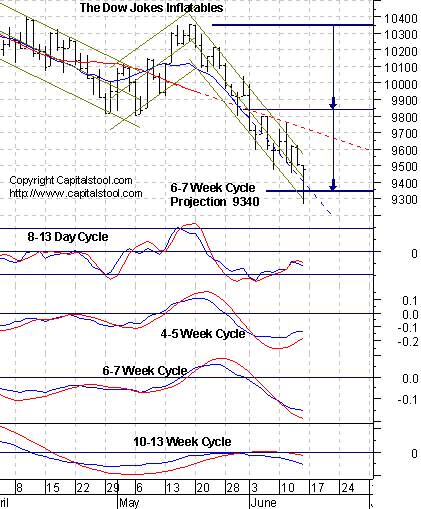 The
stage managers * stepped aside while the crowd ran amok in the first 15
minutes. It took the imposition of program trading collars to stop the
panic. When it was clear the selling was exhausted, they covered their
shorts in all the right places, and the next thing we knew, the public
shorts stepped in and did the inverse of the morning bull panic. We should
be accustomed to this spectacle by now. After being down 240, the
Inflatables ended with a minor loss of 29.
The
stage managers * stepped aside while the crowd ran amok in the first 15
minutes. It took the imposition of program trading collars to stop the
panic. When it was clear the selling was exhausted, they covered their
shorts in all the right places, and the next thing we knew, the public
shorts stepped in and did the inverse of the morning bull panic. We should
be accustomed to this spectacle by now. After being down 240, the
Inflatables ended with a minor loss of 29. 